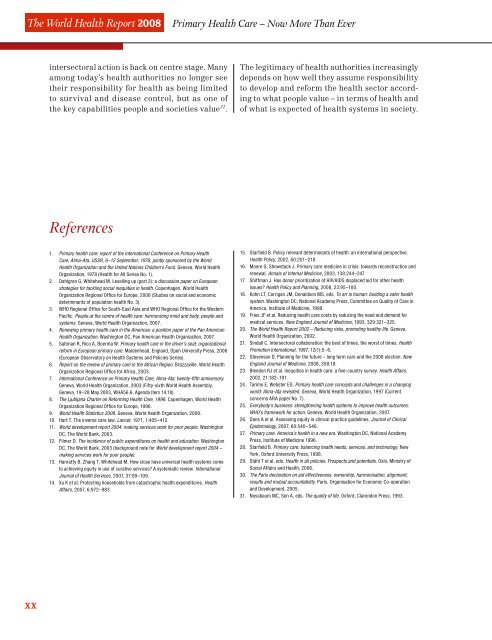Primary health care: now more than ever - World Health Organization
Primary health care: now more than ever - World Health Organization
Primary health care: now more than ever - World Health Organization
Create successful ePaper yourself
Turn your PDF publications into a flip-book with our unique Google optimized e-Paper software.
The <strong>World</strong> <strong>Health</strong> Report 2008<strong>Primary</strong> <strong>Health</strong> Care – Now More Than Everintersectoral action is back on centre stage. Manyamong today’s <strong>health</strong> authorities no longer seetheir responsibility for <strong>health</strong> as being limitedto survival and disease control, but as one ofthe key capabilities people and societies value 31 .The legitimacy of <strong>health</strong> authorities increasinglydepends on how well they assume responsibilityto develop and reform the <strong>health</strong> sector accordingto what people value – in terms of <strong>health</strong> andof what is expected of <strong>health</strong> systems in society.References1. <strong>Primary</strong> <strong>health</strong> <strong>care</strong>: report of the International Conference on <strong>Primary</strong> <strong>Health</strong>Care, Alma-Ata, USSR, 6–12 September, 1978, jointly sponsored by the <strong>World</strong><strong>Health</strong> <strong>Organization</strong> and the United Nations Children’s Fund. Geneva, <strong>World</strong> <strong>Health</strong><strong>Organization</strong>, 1978 (<strong>Health</strong> for All Series No. 1).2. Dahlgren G, Whitehead M. Levelling up (part 2): a discussion paper on Europeanstrategies for tackling social inequities in <strong>health</strong>. Copenhagen, <strong>World</strong> <strong>Health</strong><strong>Organization</strong> Regional Offi ce for Europe, 2006 (Studies on social and economicdeterminants of population <strong>health</strong> No. 3).3. WHO Regional Offi ce for South-East Asia and WHO Regional Offi ce for the WesternPacifi c. People at the centre of <strong>health</strong> <strong>care</strong>: harmonizing mind and body, people andsystems. Geneva, <strong>World</strong> <strong>Health</strong> <strong>Organization</strong>, 2007.4. Renewing primary <strong>health</strong> <strong>care</strong> in the Americas: a position paper of the Pan American<strong>Health</strong> <strong>Organization</strong>. Washington DC, Pan American <strong>Health</strong> <strong>Organization</strong>, 2007.5. Saltman R, Rico A, Boerma W. <strong>Primary</strong> <strong>health</strong> <strong>care</strong> in the driver’s seat: organizationalreform in European primary <strong>care</strong>. Maidenhead, England, Open University Press, 2006(European Observatory on <strong>Health</strong> Systems and Policies Series).6. Report on the review of primary <strong>care</strong> in the African Region. Brazzaville, <strong>World</strong> <strong>Health</strong><strong>Organization</strong> Regional Offi ce for Africa, 2003.7. International Conference on <strong>Primary</strong> <strong>Health</strong> Care, Alma-Ata: twenty-fi fth anniversary.Geneva, <strong>World</strong> <strong>Health</strong> <strong>Organization</strong>, 2003 (Fifty-sixth <strong>World</strong> <strong>Health</strong> Assembly,Geneva, 19–28 May 2003, WHA56.6, Agenda Item 14.18).8. The Ljubljana Charter on Reforming <strong>Health</strong> Care, 1996. Copenhagen, <strong>World</strong> <strong>Health</strong><strong>Organization</strong> Regional Offi ce for Europe, 1996.9. <strong>World</strong> <strong>Health</strong> Statistics 2008. Geneva, <strong>World</strong> <strong>Health</strong> <strong>Organization</strong>, 2008.10. Hart T. The inverse <strong>care</strong> law. Lancet, 1971, 1:405–412.11. <strong>World</strong> development report 2004: making services work for poor people. WashingtonDC, The <strong>World</strong> Bank, 2003.12. Filmer D. The incidence of public expenditures on <strong>health</strong> and education. WashingtonDC, The <strong>World</strong> Bank, 2003 (background note for <strong>World</strong> development report 2004 –making services work for poor people).13. Hanratty B, Zhang T, Whitehead M. How close have universal <strong>health</strong> systems cometo achieving equity in use of curative services? A systematic review. InternationalJournal of <strong>Health</strong> Services, 2007, 37:89–109.14. Xu K et al. Protecting households from catastrophic <strong>health</strong> expenditures. <strong>Health</strong>Affairs, 2007, 6:972–983.15. Starfi eld B. Policy relevant determinants of <strong>health</strong>: an international perspective.<strong>Health</strong> Policy, 2002, 60:201–218.16. Moore G, Showstack J. <strong>Primary</strong> <strong>care</strong> medicine in crisis: towards reconstruction andrenewal. Annals of Internal Medicine, 2003, 138:244–247.17. Shiffman J. Has donor prioritization of HIV/AIDS displaced aid for other <strong>health</strong>issues? <strong>Health</strong> Policy and Planning, 2008, 23:95–100.18. Kohn LT, Corrigan JM, Donaldson MS, eds. To err is human: building a safer <strong>health</strong>system. Washington DC, National Academy Press, Committee on Quality of Care inAmerica, Institute of Medicine, 1999.19. Fries JF et al. Reducing <strong>health</strong> <strong>care</strong> costs by reducing the need and demand formedical services. New England Journal of Medicine, 1993, 329:321–325.20. The <strong>World</strong> <strong>Health</strong> Report 2002 – Reducing risks, promoting <strong>health</strong>y life. Geneva,<strong>World</strong> <strong>Health</strong> <strong>Organization</strong>, 2002.21. Sindall C. Intersectoral collaboration: the best of times, the worst of times. <strong>Health</strong>Promotion International, 1997, 12(1):5–6.22. Stevenson D. Planning for the future – long term <strong>care</strong> and the 2008 election. NewEngland Journal of Medicine, 2008, 358:19.23. Blendon RJ et al. Inequities in <strong>health</strong> <strong>care</strong>: a fi ve-country survey. <strong>Health</strong> Affairs,2002, 21:182–191.24. Tarimo E, Webster EG. <strong>Primary</strong> <strong>health</strong> <strong>care</strong> concepts and challenges in a changingworld: Alma-Ata revisited. Geneva, <strong>World</strong> <strong>Health</strong> <strong>Organization</strong>, 1997 (Currentconcerns ARA paper No. 7).25. Everybody’s business: strengthening <strong>health</strong> systems to improve <strong>health</strong> outcomes:WHO’s framework for action. Geneva, <strong>World</strong> <strong>Health</strong> <strong>Organization</strong>, 2007.26. Dans A et al. Assessing equity in clinical practice guidelines. Journal of ClinicalEpidemiology, 2007, 60:540–546.27. <strong>Primary</strong> <strong>care</strong>. America’s <strong>health</strong> in a new era. Washington DC, National AcademyPress, Institute of Medicine 1996.28. Starfi eld B. <strong>Primary</strong> <strong>care</strong>: balancing <strong>health</strong> needs, services, and technology. NewYork, Oxford University Press, 1998.29. Ståhl T et al, eds. <strong>Health</strong> in all policies. Prospects and potentials. Oslo, Ministry ofSocial Affairs and <strong>Health</strong>, 2006.30. The Paris declaration on aid effectiveness: ownership, harmonisation, alignment,results and mutual accountability. Paris, Organisation for Economic Co-operationand Development, 2005.31. Nussbaum MC, Sen A, eds. The quality of life. Oxford, Clarendon Press, 1993.xx

















